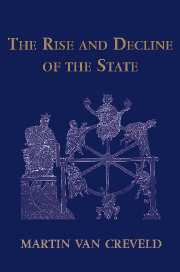Book contents
5 - The spread of the state: 1696 to 1975
Published online by Cambridge University Press: 26 June 2009
Summary
The earliest political units deserving to be called states were France, Spain, Portugal, Britain, the countries composing the Holy Roman Empire and Scandinavia, and the Netherlands. During the first century or so of their existence all of these combined occupied only between 2 and 3 percent of the earth's surface: to be precise, 1,450,000 square miles out of a global land mass of 57,000,0000. All other parts of the world continued to be inhabited, as they had been since time immemorial, by tribes without rulers, more or less centralized chiefdoms, and empires of various sizes and descriptions. Here and there, as along the East African coast and also in parts of what are today Malaysia and Indonesia, history points to the existence of city-states too sophisticated to be called chiefdoms and not subject to larger empires. However, there were apparently none that were run on nonproprietary, democratic lines like those of ancient Greece and Rome.
This much granted, the spread of the state into other continents and its victory over other polities may be studied in one of three ways. The first would be to proceed chronologically without regard to location: in other words, to follow the march first of imperialism and then of decolonization as it took place. The second would be to proceed geographically: i.e., divide the world into various regions and trace the way each one separately came to be divided into, and ruled by, states.
- Type
- Chapter
- Information
- The Rise and Decline of the State , pp. 263 - 335Publisher: Cambridge University PressPrint publication year: 1999



